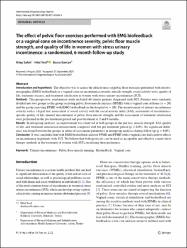The effect of pelvic floor exercises performed with EMG biofeedback or a vaginal cone on incontinence severity, pelvic floor muscle strength, and quality of life in women with stress urinary incontinence: a randomized, 6-month follow-up study

View/
Access
info:eu-repo/semantics/embargoedAccessDate
14.01.2022Metadata
Show full item recordCitation
Sahin, N., Yesil, H., & Gorcan, B. (2022). The effect of pelvic floor exercises performed with EMG biofeedback or a vaginal cone on incontinence severity, pelvic floor muscle strength, and quality of life in women with stress urinary incontinence: a randomized, 6-month follow-up study. International Urogynecology Journal, 1-7.Abstract
Introduction and hypothesis
The objective was to assess the effectiveness of pelvic floor exercises performed with electromyographic (EMG) biofeedback or a vaginal cone on incontinence severity, muscle strength, social activity level, quality of life, treatment success, and treatment satisfaction in women with stress urinary incontinence (SUI).
Methods
This prospective, randomized study included 40 female patients diagnosed with SUI. Patients were randomly divided into two groups as the group receiving pelvic floor muscle exercise (PFME) with a vaginal cone at home (n = 20) and the group receiving PFME with EMG biofeedback in the hospital (n = 20). The measurement of urinary incontinence severity with a 1-h pad test, assessment of social activity with the social activity index (SAI), assessment of incontinence-specific quality of life, manual measurement of pelvic floor muscle strength, and the assessment of treatment satisfaction were performed in the pre-treatment period and post-treatment at 3 and 6 months.
Results
In intragroup analyses, an improvement was observed in both groups in the pad test, muscle strength, SAI, quality of life, and treatment satisfaction measurement compared with the pre-treatment period (p < 0.05). No significant difference was found between the groups in terms of assessment parameters in intergroup analyses during follow-up (p > 0.05).
Conclusion
It was concluded that both EMG biofeedback assisted PFME and PFME with a vaginal cone had curative effects on incontinence in patients with SUI. We believe that both protocols can be used as acceptable and effective conservative therapy methods in the treatment of women with SUI considering their preference.















